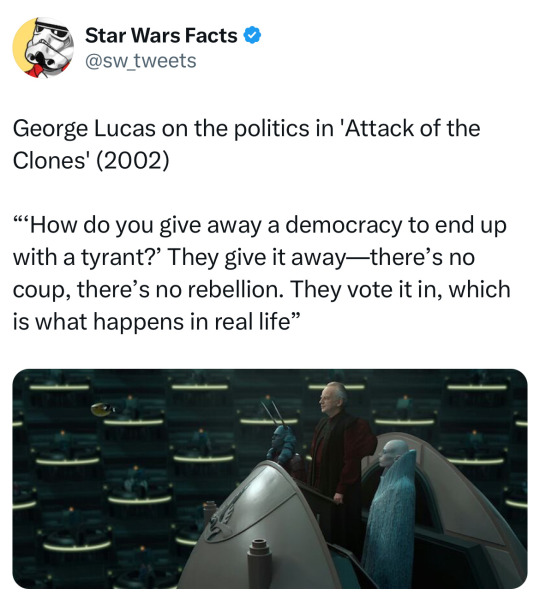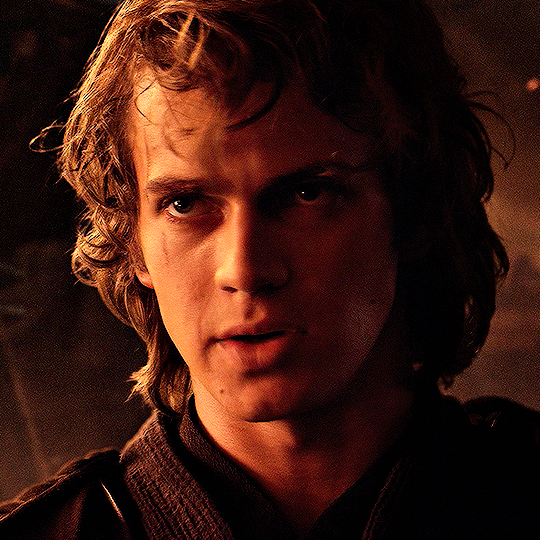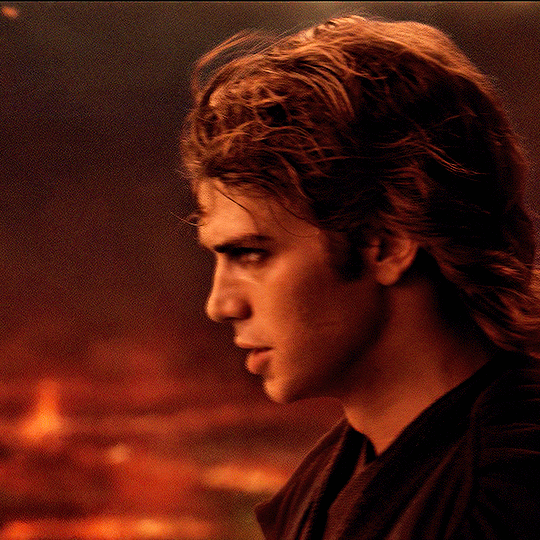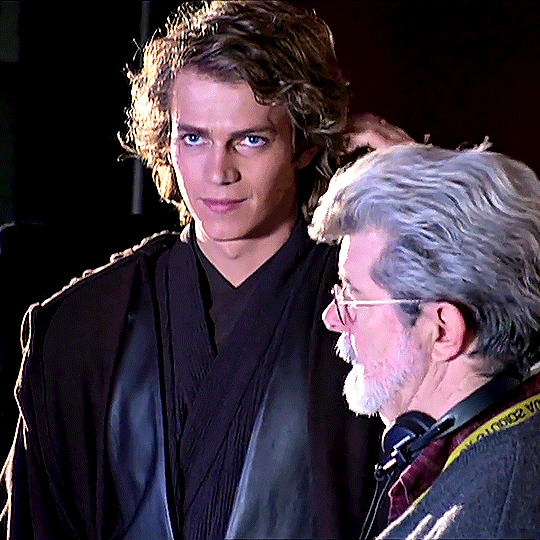#lucas skywalker...
Explore tagged Tumblr posts
Text
please remember that luke skywalker adopted rey and fin a few years after marrying din djarin and and opening his jedi school on mandalor with their green rat son.
#poe just like apeared on day and as a teen and begged to take the creed#never forget how lucas skywalker married the king of mandalor#lucas skywalker...#hehe#dinluke#din djarin#jedi can have attachments and the bond between so many of them in the prequels and clone wars is proof of that#if a normal person doesn't regulate their emotions they can become terrible and that applied to jedi#so if luke trains the kids to not be stupid shits then we can avoid sith lords#also kylo (ben) will begin training to take the creed when he is 11 becuase he thinks being a jedi is lame like his mom#ben also thinks that din is like the coolest fucking person and then he meets boba and hear about his dads time in cryo and is like:#yup that seals the deal give me my helmet#i miss finpoe so bad guys#and reys lesbian ass oh god i miss her#like booo the sequels but i love my gay ppl#luke skywalker#rey skywalker#finnpoe#finn#fuck what's his last name it's been a minute he doesn't actually have one what do we call him#grogu djarin#the way that we gave him dons last name HOLD ME#m rants in the tags
395 notes
·
View notes
Text

I’m so sorry we didn’t learn, George.
#Star Wars#George Lucas#Democracy#Election 2024#Vote#Donald Trump#Kamala Harris#So this is how liberty dies#with thunderous applause#Obitine#anidala#Padme Amidala#Satine Kryze#Obi-Wan Kenobi#Anakin Skywalker#Sheev Palpatine
13K notes
·
View notes
Text




HAYDEN CHRISTENSEN as ANAKIN SKYWALKER Star Wars: Episode III - Revenge of the Sith 2005, dir. George Lucas
#star wars#anakin skywalker#hayden christensen#darth vader#swedit#filmgifs#moviegifs#starwarsblr#revenge of the sith#star wars revenge of the sith#tuserlivia#tuserhan#userdickon#filmedit#george lucas#prequelsnet#cinema#cinematv#tvandcinemas
3K notes
·
View notes
Text

i saw this tweet and absolutely had to make a comic out of it because i cant stop imaging anakin just visibly seething in the presence of ki adi mundi asdkjsdlkj
#anakin skywalker#ki adi mundi#star wars#prequels#revenge of the sith#art#comic#jedi#sw#rots#attack of the clones#george luca#reading the sw prequel novels#they add so much to the lore#revenge of the sith i will always love you#ani#padme amidala#kill yourself mention
2K notes
·
View notes
Text
Some of you are too afraid to admit this but we all know Star Wars works best when it goes full soap opera
#literally this entire franchise started because of a secret marriage and twins separated at birth#they’ve done amnesia plots and everything#embrace the camp#star wars#revenge of the sith#a new hope#the force awakens#the last jedi#the phantom menace#duel of the fates#the clone wars#the bad batch#the acolyte#mai aniseya#osha aniseya#osha x qimir#oshamir#qimir#reylo#kylo ren#luke skywalker#leia organa#han solo#baby yoda#the mandalorian#ashoka tano#andor#rogue one#george lucas#Disney
5K notes
·
View notes
Text


Padme & Anakin
Promotional stills for Star Wars Episode II: Attack of the Clones
#anidala#anakin skywalker#star wars anakin#anakin and padme#anakin#ani#sw anakin#Star Wars#Star Wars prequels#Star Wars prequels trilogy#star wars episode ii: attack of the clones#ani x padme#padme amidala#star wars padme#sw padme#padme and anakin#padme x anakin#George Lucas#natalie portman#hayden christensen#naboo#senator amidala#Jedi#film#film photography#film stills#movie still#sci fi and fantasy#lovers#forbidden love
750 notes
·
View notes
Text
#tumblr polls#george lucas#disney star wars#star wars#jedi#cal kestis#nightsister merrin#calmerrin#star wars jedi survivor#ezra bridger#sabine wren#rey palpatine#din djarin#bo katan kryze#bo katan x din#the mandalorian#obi wan kenobi#anakin skywalker#padme amidala#rogue one#cassian andor#Andor#luke skywalker#emperor palpatine#ahsoka tano#clone wars#the clone wars#star wars rebels#count dooku#star wars the clone wars
849 notes
·
View notes
Text

In case you guys wanna cry a bit
#anakin skywalker#obi wan kenobi#ben kenobi#padme amidala#senator amidala#ashoka tano#clone wars#shmi skywalker#darth vader#darth sidious#revenge of the sith#star wars#luke skywalker#leia organa#princess leia#return of the jedi#phantom menace#attack of the clones#star wars prequels#jedi#jedi order#jedi survivor#jedi knight#star wars clone wars#george lucas#disney#disney star wars can’t compete#The force#sw#sw memes
591 notes
·
View notes
Text
Aite let’s do this. Here’s my thoughts on the Jedi’s Attachment rule and why it exists:
Attachment and love/affection are two very different things. You can be loving and affectionate without being attached to someone.
The same way, letting go doesn’t mean forgetting. It’s accepting the way things are and that death and loss are a natural part of life. You can’t fight what’s natural. It also doesn’t mean to sit back and just accept things as they are, or why would Jedi fight to protect? To change things and save people?
Love is knowing to put the many over the few. If someone you love is in danger, but there’s also a boatload of civilians, it’s going for the civilians, even if you hate them, despite wanting to save the other. ie. Letting go of your feelings. Not being attached.
So why this rule is such a big deal.
For a Jedi, being *attached* poses a much bigger problem than for the average person (looking at you Anakin Skywalker.) If a normal person can go to extremes either as a result of losing someone or wanting to protect them, think of what a Jedi, who feels things more deeply because of the Force, could do if they can’t let go.
The important thing is Jedi don’t say ‘don’t love.’ They don’t say ‘feel nothing.’ In fact you often hear Obi-wan and others say to trust feelings, instincts and refer to each other affectionately.
Anakin: You’re like a father to me.
Obi-Wan: Then why don’t you *listen.*
(Episode II. Not a reprimand for calling him father-like but asking if that’s how he feels, why doesn’t Anakin listen like a son should.)
What they *do* say is don’t get carried away in positive or negative feelings, as both can lead to impulsive actions with long term consequences. It’s a concept that follows the lines of mindfulness and just being *aware* that they have so much power, they can’t afford to be reckless. Because the damage *will* be long lasting.
They say don’t love someone so much that you’ll do anything for them. They say don’t be *possessive.* Because that’s a *very* dangerous place to go for a normal person, let alone a super powerful being who could leave *chaos* behind. Attachment is refusing to let go. Stopping someone from doing what they love because you’re scared. Love is trusting and accepting things can’t/will change even if you don’t like it, and accepting that when there’s nothing you can do without breaking your moral code.
Jedi grieve. They feel loss. They get angry. They *love.* They just don’t let those feelings overwhelm them to the point of irrationality, accepting, understanding, and releasing them because they’ll do no good in the long run. If emotion overwhelms the brain, the logical part shuts down, and we’ve all seen what force fuelled temper/grief can do.
‘Kanan and Ezra don’t follow the rule.’
On the contrary.
You see Kanan learn to let go of his grief and *attachment* which has been holding him back all this time. In doing so he becomes a Knight and Master. He loves Hera, yes, but he loves unconditionally. Not possessively. He’s fine with Hera going on dangerous missions and accepts that there will be times she’s hurt. That there’s always a possibility she might not come back and he’s gonna have to live with that. He doesn’t try to stop her. He doesn’t fall into a rage if she gets hurt. He accepts it, pain, rage, grief and all, but lets it go so he doesn’t become fearful to the point he won’t let *her* go. He accepts Hera loves the Rebellion and compromises even if he doesn’t like it. Love. Nothing wrong with that in the Jedi Order.
In contrast you have Anakin. When Padmé is in danger he will drop *everything* to go to her, including putting his men and padawan in unnecessary danger to do so. You see his jealousy when Clovis is around. His lack of faith in Padmé despite her assurances. How he won’t back down even if it scares or disturbs her. You see how he *refuses* to take any chances at all with her health to the point of breaking his moral code. This isn’t love anymore. This is attachment, possession. This is what the Jedi forbid.
You see Ezra struggle with letting Sabine go on a dangerous mission and Kanan teaching him that he has to accept the danger, that she might not come back. and how to do it. Telling him to respect her abilities, what she wants to do, and not loving her to the point of stifling her. This is what letting go is. This is what the Jedi teach.
Ezra has to learn to let go of his own grief and accept Kanan’s death. This is what love without attachment means. This is what the rule is. Feeling it. Accepting it. Then letting the emotions go so they don’t control your actions more than your mind does.
Also, anyone can leave the Jedi Order. If they don’t agree, there’s nothing forcing them to stay. Being a Jedi is a religion, a way of life. You can discuss and debate the details, but you don’t get to pick and choose what parts to follow.
You can be a force wielder without being a Jedi. The privileges the Jedi received were because of their belief and the respect that earned.
But more importantly, you can happily leave the order, and the Jedi will still welcome you to come hang out. To chill with your friends and walk about the Temple, train with others and catch up. It’s a community. You don’t suddenly lose all of that because you decided following the Jedi way wasn’t for you.
#aite let’s see who this reaches?#I don’t want to call it pro Jedi because it’s more like.#this is how George Lucas created the Jedi#and I’m sorry I absolutely *despise* the way new shows have taken this beautiful Order#and rewritten entire aspects of it just so they can make Anakin look good#this isn’t even a theory. look at what Lucas says about the Jedi and Anakin vs what Filoni keeps saying about Anakin being the best Jedi#and how clearly this plays with Ahsoka#and how he shows Dooku and the Jedi in Tales of the Jedi#vs what was previous canon#aaaanyway. Tags!#Jedi#jedi culture#jedi order#anakin Skywalker#padme amidala#obi wan kenobi#kanan jarrus#ezra bridger#Star Wars#star wars meta#call me biased but loving without being attached is such a core part of my own faith#it’s something I’ve grown up around and just makes sense to me#so here’s my expansion on why the Jedi might have it ^^
586 notes
·
View notes
Text
the deep seeded connection between me and a overpowered smiley faced blond haired blue eyed fictional man.
#AND he's gay#naruto#naruto uzumaki#thor#marvel thor#thor odinson#luke skywalker#lucas skywalker...#hehe#I LOVE SUNSHINE BOYS SO BAD#my blorbo
4 notes
·
View notes
Text




REVENGE OF THE SITH (2005) dir. George Lucas
#angelslatte#filmedit#swedit#rotsedit#star wars#revenge of the sith#xuseremily#robincomelook#gifs**#sw parallels#anakin skywalker#hayden christensen#mace windu#samuel l. jackson#darth sidious#ian mcdiarmid#ptedit#george lucas
433 notes
·
View notes
Text


Natalie Portman and Hayden Christensen - Star Wars: Episode II – Attack of the Clones (2002)
#natalie portman#hayden christensen#attack of the clones#padmé amidala#anakin skywalker#star wars#episode ii#george lucas#2000s sci-fi#2000s movies#2002
713 notes
·
View notes
Text




Star Wars: Episode VI - Return of the Jedi 1983, dir. Richard Marquand
#star wars#swedit#return of the jedi#luke skywalker#mark hamill#leia organa#carrie fisher#anakin skywalker#hayden christensen#starwarsblr#filmgifs#moviegifs#dailyflicks#dailyanakin#tuserlivia#tuserhan#userdickon#filmedit#movieedit#cinema#george lucas#tvandcinemas#cinematv#cinemapix#filmtvcentral
2K notes
·
View notes
Text

kenobi instinct: claiming the high ground
#anakin skywalker#hayden christensen#obi-wan kenobi#ewan mcgregor#george lucas#lucas is SO pocket sized haha#in comparison anyway#sw bts#star wars#sw#from rinzler's making of the revenge of the sith
1K notes
·
View notes
Text
on the aesthetics of asian erasure in star wars: obi-wan kenobi and the planet of naboo

when we talk about representation in star wars, the conversation often stops at what’s visible or credited. star wars has a long-standing problem with the lack of asian leads or asian-coded worlds, but sometimes what’s more insidious is the erasure of asian influence where it once existed, or where it was clearly intended to be.
take obi-wan kenobi. before alec guinness was cast, george lucas had reportedly wanted a japanese actor to play the role, toshirō mifune, most famously known for his work with akira kurosawa. lucas has never strayed away from citing the hidden fortress as a direct inspiration for a new hope, and the jedi, in their original conception, from eastern philosophies, particularly bushido and zen buddhism. this was not accidental. it’s embedded into the language, “obi” (the sash of a kimono), “wan” (a name component common in chinese and southeast asian names), and “kenobi,” which emulates the structure of japanese surnames. it is an asian-inspired name, heavily so.
but when mifune declined, lucas pivoted. and instead of keeping that vision intact, the jedi master archetype, the wise elder, steeped in tradition, was lifted from its asian origins and handed to a white british actor. and then later, to ewan mcgregor, whose performance, while incredible, westernized the role further. we are told obi-wan is from “stewjon,” a planet born out of a joke, a merging of jon stewart’s name, after he asked lucas where obi-wan was from. then “space scotland” became the shorthand. that change from asian inspiration to european performance was never really questioned.
it’s not about demanding obi-wan look asian. it’s that the character was rooted in an asian framework, and that framework was abandoned the moment it became inconvenient to uphold. and that sets the tone for much of star wars, aesthetic borrowing without meaningful credit.
naboo is another case where this shows up. the common narrative is that naboo was inspired by renaissance europe, with its lush italian architecture, baroque dresses, and romanticized monarchy. those elements are there. but there’s a consistent thread of asian influence that is almost never acknowledged.
the names of the monarchs are a starting point. padmé, from the sanskrit “padma,” meaning lotus. sabé and saché, echoing asian and hindi name constructions. queen jamillia, whose name stems from arabic roots, suggests influence from islamic culture. even the name “naboo” itself sounds curiously close to nebo, a mesopotamian god, or nabu, the sumerian deity of wisdom. the planets closest to naboo in the galactic grid, like sereno and ord mantell, also carry vague echoes of eurasian tone.
but most significantly, look at the costume design in the phantom menace. trisha biggar drew from a range of global influences, but some of queen amidala’s most iconic gowns were directly modeled after traditional mongolian royal attire, specifically the headdress and layered robes worn by mongolian empresses. the high collars, rich brocades, and facial makeup are unmistakable. yet, in the lore, naboo is labeled as european. not central asian. not global. and certainly not asian.
this is not to say star wars owes its worldbuilding to any one culture. it doesn’t. part of its power comes from its ability to merge and reimagine cultures. but there is a problem when the contributions of asian cultures are stripped of credit, while european aesthetics are exalted as canonical. when a jedi’s name can be asian, his values drawn from eastern philosophies, his robes loosely modeled on samurai garb, and yet his face, voice, and homeworld are made definitively western.
#star wars#obi wan kenobi#george lucas#ewan mcgregor#naboo#padme amidala#padme naberrie#sabe#leia organa#breha organa#bail organa#luke skywalker#jedi#sith#darth vader#han solo#cassian andor#mon mothma#luthen rael#bix caleen#kleya marki#qui gon jinn#ki adi mundi#mace windu#yoda#shaak ti#ahsoka tano#plo koon#anakin skywalker#kit fisto
321 notes
·
View notes
Text


Hayden + Directors | Ahsoka (2023) + Revenge of the Sith (2005)
#maybe cheesy but I like how it looks like he's giving knowing glances to himself lol#hayden christensen#sweet canadian farm prince#my sun and stars#anakin skywalker#ahsoka series#revenge of the sith#rots#behind the scenes#dave filoni#george lucas#userlace#tusermelissa#my gifs#gsaswgifs
456 notes
·
View notes